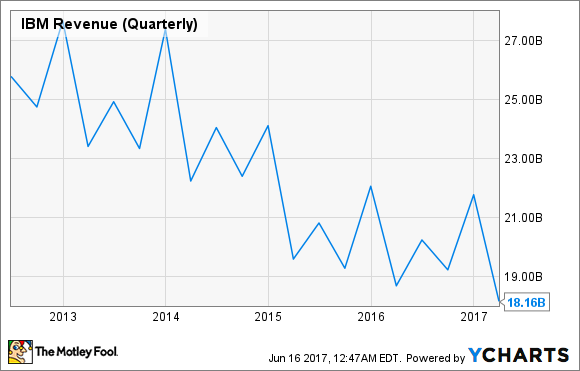IBM (IBM 1.05%) isn't an easy stock to own. The tech giant's revenue seems to be in constant decline, its cloud-based growth seems lackluster compared to bigger players like Amazon, and even Warren Buffett -- who is renowned for his patience -- seems to be giving up.
IBM can be a confusing company to analyze, since it's comprised of so many moving parts. To better understand Big Blue, let's take a look at seven charts which highlight the key points of its business.

IBM's Sequoia supercomputer. Source: IBM.
Revenue growth
IBM's quarterly revenue has fallen year-over-year for 20 straight quarters. That situation won't improve anytime soon -- analysts expect its revenue to fall 2% this year.
Source: YCharts
That ongoing decline can be attributed to sluggish enterprise spending, tough competition in the IT services industry, and higher-growth businesses failing to grow quickly enough to offset declines at its legacy businesses. Currency headwinds are also exacerbating that pain.
IBM's revenue growth notably lags some of its rivals in the IT services space. Accenture (ACN -1.04%), for example, grew its sales by 6% in fiscal 2016, and analysts expect 5% growth this year.
Strategic imperatives growth
IBM places its five "higher-growth" businesses -- cloud, mobile, social, security, and analytics -- into a sub-category dubbed "strategic imperatives" (SI). In recent quarters, IBM has emphasized the annual growth of its SI businesses, and their overall weight on the company's top line over the past 12 months:
|
Q1 2016 |
Q2 2016 |
Q3 2016 |
Q4 2016 |
Q1 2017 |
|
|
SI annual growth |
14% |
12% |
16% |
13% |
12% |
|
% of IBM's trailing 12-month revenue |
37% |
38% |
40% |
41% |
42% |
Source: IBM quarterly reports.
The weight of the SI businesses on IBM's top line is increasing, but their growth has slowed down over the past two quarters. That's why IBM is still unable to offset the slower growth across its older IT services, software, and hardware businesses. Here's a how the five SI businesses fared last quarter:
|
Q1 2017 |
Revenue (billions USD) |
Year-over-year growth |
|
Analytics |
$4.5 |
7% |
|
Cloud |
$3.5 |
35% |
|
Mobile |
$1.0 |
22% |
|
Security |
$0.5 |
10% |
|
Social |
$0.2 |
(3%) |
Source: IBM Q1 2017 presentation.
Revenue by business unit
IBM's SI businesses are scattered across its five main business units -- Technology Services & Cloud Platforms, Global Business Services, Cognitive Solutions, Global Systems, and Financing -- and mixed in with its legacy businesses. Here's how much revenue each of its five core businesses brought in during the first quarter:

Q1 2017 Revenue. Source: IBM.
The only business that posted annual revenue growth last quarter was Cognitive Solutions, which was driven by its growth in security and analytics -- which is powered by its AI platform, Watson.
Reining in the buybacks
Back in 2010, then-CEO Sam Palmisano promised to double IBM's annual earnings per share from $10.01 in 2009 to $20 by 2015. To reach that lofty goal, Palmisano aggressively bought back stock. This was a big mistake, because IBM should have invested that cash into higher growth cloud and mobile technologies to stay ahead of the tech curve.
After Ginni Rometty took over as CEO in 2012, she continued Palmisano's buyback plans. But in late 2014, she finally abandoned Palmisano's "Roadmap 2015" plan and dramatically reduced buybacks, allocating IBM's free cash flow toward investments in strategic imperatives instead:
Source: YCharts
Earnings growth
That was a painful but necessary move, because Rometty realized that resuscitating IBM's top line growth mattered more than artificially propping up its bottom line growth. Nonetheless, IBM's earnings decline after the reduction of buybacks stunned many investors:
Source: YCharts
Analysts expect IBM's earnings to grow less than 1% this year. Meanwhile, Accenture -- which traditionally spends a much lower percentage of its FCF on buybacks -- is expected to post 10% earnings growth this year.
Dividend growth
IBM certainly faces a lot of challenges, but one bright spot is its dividend. The company pays a forward yield of 3.9%, and it's raised that dividend every year for 22 straight years.
Source: YCharts
IBM can afford to keep raising that dividend, since it only spent 46% of its earnings on those payments over the past 12 months. In other words, Big Blue will keep paying you to wait for its strategic imperatives growth to offset its losses across its legacy businesses. But that could take a very long time.









